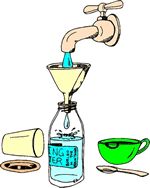Water Purification

In tropical countries, the drinking water is often insufficiently chlorinated or not chlorinated at all. Therefore, you should not use it to brush your teeth, let alone for drinking.
Most travellers have access to bottled water and therefore do not need to think about any special water purification measures.
If you are going to be a little more adventurous far outside of civilisation, the situation might be different. If you do not have access to pure water, then your water needs to be treated. This is primarily done by boiling or else through ceramic filtering and / or chemical treatment.
However, this depends on you having access to rather clear water. If not, then the water must first be coarse filtered or else you must allow the water to undergo sedimentation.
Coarse filtering
is most easily done using a single or double coffee filter (good to bring along). A dense fabric, such as denim, can also work.
Sedimentation
is most suitable if the water contains heavier particles, such as sand. Let the water rest undisturbed for a few hours in a bottle, a bucket etc. so that the particles sink to the bottom. The higher and narrower the vessel, the faster the water clears.
The coarse-filtered or sediment water is then made potable by
- boiling
- ceramic filtering
- chemical treatment
- Ceramic filtering and chemical treatment
Boiling
is absolutely the most effective way of rendering infectious substances harmless. It is often enough simply to boil the water. If you want to be perfectly sure, let it boil for about a minute and then let it cool. If you like, you can flavour the water with a little salt and lemon.
At high elevations, water boils at lower temperatures and then the boiling time must be somewhat extended. At heights of over 4000 metres, it is enough, however, to boil it for about 5 minutes.
Ceramic Filtering
The size of the pores in ceramic filters vary, but as a rule they are so small that parasites and bacteria are effectively separated. However, viruses can be smaller than the size of the pores and are therefore not always separated. Depending on the quality of the filter, the filtered water should - in certain cases - be chemically treated afterwards.
Ceramic filters are available in different sizes and are sold in well-stocked sport and leisure shops.
Chemical Treatment
Before the water is treated chemically, you should always try to filter it, e.g., through coffee filters, pieces of fabric or similar. However, ceramic filters are the best.
Iodine Tablets (e.g., Potable Aqua, which is also available abroad) are also effective. However, iodine preparations should not be used by children or pregnant women, nor by people with any kind of thyroid illness.
Chlorine (4-6%) e.g., laundry bleach is easy to obtain, but is an inferior alternative to the tablets above.Fill a plastic bottle with clear, lukewarm water and add 2 drops per litre of water. Shake thoroughly and let it stand for at least 30 minutes. You should be able to sense a weak chlorine odour - if not, repeat the treatment and let it stand another 30 minutes.
If the water is cold or slightly turbid, use four drops of chlorine per litre of water.
Storage
Boiled water must be stored cool in clean, well-sealed vessels. Remember that once it has boiled, cooled water can become contaminated again. A little air in the bottle removes the stale flavour. If there is no refrigerator, boiled water can be stored at room temperature for a brief period.
Packages of disinfectant tablets must be kept sealed so that the tablets do not become damp or exposed to air, as that reduces their effectiveness.
